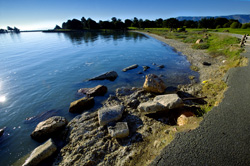Urban Parks
Not all state parks are in remote areas. Recent acquisitions have focused on bringing parks directly into the heart of cities, including the acquisition of Rio de Los Angeles State Park along the Los Angeles River, and Los Angeles State Historic Park in downtown Los Angeles.

Parks in urban areas, such as Candlestick Point State Recreation Area (pictured here), play a critical role in climate change mitigation and adaptation.
Have you ever noticed it’s hotter in the city among the asphalt and concrete than in a wooded or grassy area? Trees and bushes don’t only provide shade, they also turn sunlight into food, reducing the amount of heat absorbed and reflected from built surfaces. In the city, the lack of greenspace and trees can lead to an overwhelming buildup of heat. This so-called heat island effect sometimes causes death and sickness. It also exacerbates ozone and air pollution.
As climate change drives increases in temperature and air pollution, heat islands are going to get even hotter, and more common. Urban area parks can help. Studies have shown that increasing the amount of greenery in a city can keep temperatures at historic lows.
Parks also provide an escape from the heat on a hot summer day. A study conducted in the Los Angeles Basin found that park temperatures were significantly lower than surrounding areas.
Trees in urban parks also contribute to carbon sequestration. Each tree planted initially can sequester as much as 1.0 to 1.3 pounds of carbon each year, with their future sequestration potential up to 100 pounds annually.
by Caryl Hart, Ph.D, and Jackson Vanfleet-Brown
